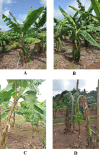Effects of In Vitro Polyploidization on Agronomic Characteristics and Fruit Carotenoid Content; Implications for Banana Genetic Improvement
- PMID: 31781149
- PMCID: PMC6861373
- DOI: 10.3389/fpls.2019.01450
Effects of In Vitro Polyploidization on Agronomic Characteristics and Fruit Carotenoid Content; Implications for Banana Genetic Improvement
Abstract
Bananas (Musa spp.), native to South East Asia, have spread worldwide and are integrated into the diets of millions of people in tropical regions. Carotenoid content varies dramatically between different banana genotypes, providing an opportunity for vitamin A biofortification. Polyploidization is a useful tool for crop improvement with potential to generate new diversity, especially in a polyploid crop like bananas. Ten induced tetraploids generated from six diploid banana genotypes were evaluated for their agronomic attributes and fruit carotenoid content in comparison to their diploid progenitors. Tetraploids had distinct plant morphology, but generally displayed inferior vegetative and yield characteristics with 20% lower bunch weights than their original diploids. Similarly, a 50% decrease in fruit provitamin A carotenoids (α-carotene, 13-cis β-carotene, 9-cis β-carotene, trans-β-carotene) accompanied by a corresponding increase in lutein was recorded in induced tetraploids in comparison to their original diploids. Additionally, all lines were subjected to pollen viability tests to assess their fertility. Pollen viability tests indicated over 70% viability for induced tetraploids and diploid controls, suggesting their possible use in crosses. These findings provide a basis for the application of induced polyploidization in bananas to generate useful genetic material for integration in hybridization programmes aiming to produce vitamin A enriched triploids valuable to malnourished populations.
Keywords: banana genetic improvement; biofortification; carotenoid content; diploid bananas; in vitro polyploidization; pollen viability; vitamin A.
Copyright © 2019 Amah, van Biljon, Maziya-Dixon, Labuschagne and Swennen.
Figures





Similar articles
-
Variability of carotenoids in a Musa germplasm collection and implications for provitamin A biofortification.Food Chem X. 2019 Apr 8;2:100024. doi: 10.1016/j.fochx.2019.100024. eCollection 2019 Jun 30. Food Chem X. 2019. PMID: 31432011 Free PMC article.
-
Recent advances in banana (musa spp.) biofortification to alleviate vitamin A deficiency.Crit Rev Food Sci Nutr. 2019;59(21):3498-3510. doi: 10.1080/10408398.2018.1495175. Epub 2018 Oct 4. Crit Rev Food Sci Nutr. 2019. PMID: 29999424
-
Genotype and ripening method affect carotenoid content and bio-accessibility in banana.Food Funct. 2024 Apr 2;15(7):3433-3445. doi: 10.1039/d3fo04632j. Food Funct. 2024. PMID: 38436090
-
Carotenoid-rich bananas: a potential food source for alleviating vitamin A deficiency.Food Nutr Bull. 2003 Dec;24(4):303-18. doi: 10.1177/156482650302400401. Food Nutr Bull. 2003. PMID: 14870618 Review.
-
From crossbreeding to biotechnology-facilitated improvement of banana and plantain.Biotechnol Adv. 2014 Jan-Feb;32(1):158-69. doi: 10.1016/j.biotechadv.2013.09.010. Epub 2013 Oct 1. Biotechnol Adv. 2014. PMID: 24091289 Review.
Cited by
-
Cytogenetics and Consequences of Polyploidization on Different Biotic-Abiotic Stress Tolerance and the Potential Mechanisms Involved.Plants (Basel). 2022 Oct 12;11(20):2684. doi: 10.3390/plants11202684. Plants (Basel). 2022. PMID: 36297708 Free PMC article. Review.
-
In vitro induction and characterisation of tetraploid drumstick tree (Moringa oleifera Lam.).Open Life Sci. 2020 Nov 18;15(1):840-847. doi: 10.1515/biol-2020-0087. eCollection 2020. Open Life Sci. 2020. PMID: 33817270 Free PMC article.
-
A Novel Banana Mutant "RF 1" (Musa spp. ABB, Pisang Awak Subgroup) for Improved Agronomic Traits and Enhanced Cold Tolerance and Disease Resistance.Front Plant Sci. 2021 Sep 23;12:730718. doi: 10.3389/fpls.2021.730718. eCollection 2021. Front Plant Sci. 2021. PMID: 34630479 Free PMC article.
References
-
- Bakry F., Carreel F., Jenny C., Horry J. P., (2009). “Breeding plantation tree crops: tropical species,” in Genetic improvement of banana. Ed. Jain S. M. (New York: Springer; ), 3–50.
-
- Bakry F., de la Reberdiere N. P., Pichot S., Jenny C. (2007). In liquid medium colchicine treatment induces non-chimerical doubled-diploids in a wide range of mono-and interspecific diploid banana clones. Fruits 62, 3–12. 10.1051/fruits:2006043 - DOI
LinkOut - more resources
Full Text Sources
Miscellaneous

